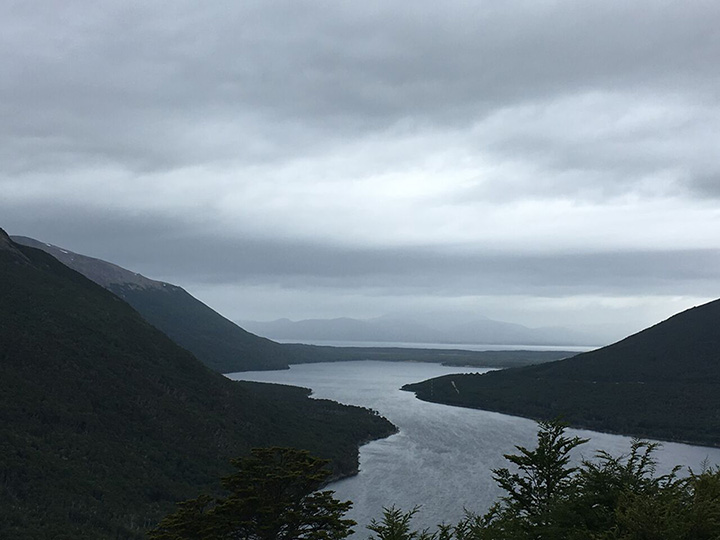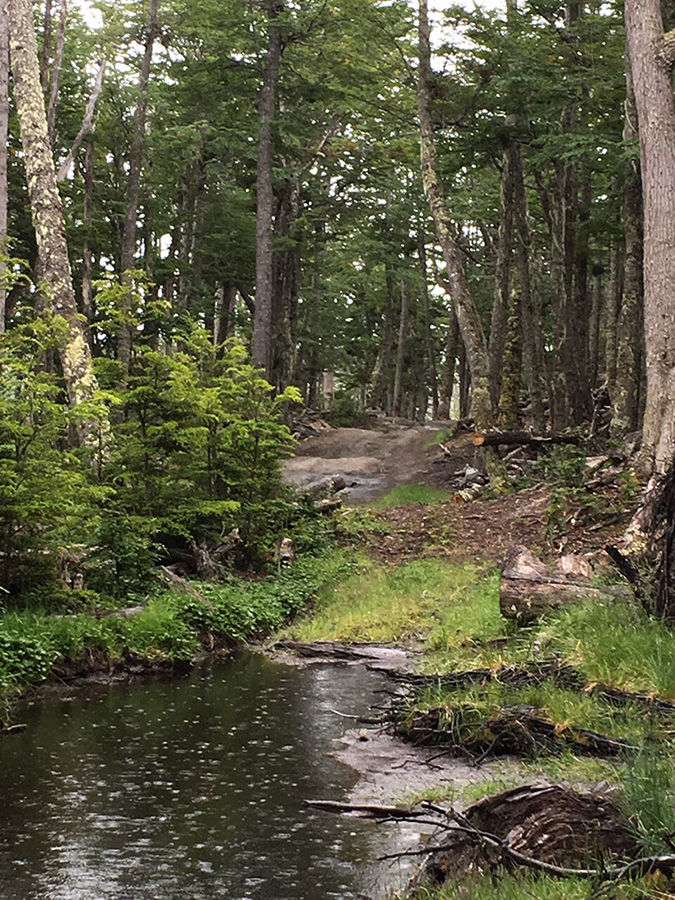Argentina Part Two: Ushuaia, the end of the world
As we flew into Ushuaia airport I could tell the pilot was having to do some maneuvering swooping down in-between the mountains and dealing with the heavy winds. A province of Argentina, Tierra del Fuego is an island that sits at the southernmost tip of South America. Ushuaia, its capital, is on the Beagle Channel about half-way between the Atlantic and Pacific Oceans, 620 miles from Antarctica. The meeting of the two oceans along with the mountainous terrain creates a strange weather pattern. It was usually very windy and could rain, be sunny, be stormy, windy raining, all within the same hour. It never rained for long and usually not very heavily. We could be out walking in the rain and never feel wet.
Once we hit the ground, I started to cry. It had taken me more than 30 years to get there but I was finally there. It was an amazing feeling. And the beauty of it did not disappoint, it was even more beautiful than I had imagined. The light and color was like nothing I had seen before. The area was dominated by snow covered mountains all around. Before arriving I had been worried that the excursions I had reserved would be cancelled because the weather forecast called for rain every day. I soon realized, rain meant nothing in Ushuaia. Life went on no matter what the weather was. One of our tour guides said the only people carrying umbrellas in Ushuaia were tourists. Because of the winds, umbrellas were useless.

We visited the prison museum our first day in Ushuaia. It was a good introduction to the island as it included anecdotes about the prisoners, some of the escapees, the history of the area, and even had a small art museum.
In 1902, the Argentine government formed a penal colony on Tierra del Fuego just outside of the small village of Ushuaia. At the time there were only about 40 houses on the island. The worst repeat offenders were sent to serve out their time, sometimes for life, building a prison and infrastructure to go with it. At one point they had more than 600 convicts living there. The cells were meant to be for one person but they would often have to double up.
The only heat was a wood stove in the middle of the building. It was cold. The prisoners built a small railroad going into the forest to help them haul wood back to their buildings once they had chopped down trees. Now it is a popular ride for the tourists. The prison closed in 1947 for humanitarian reasons and a Naval base was installed in 1950.
By then the area had grown and since there were no land animals to speak of, the government decided it would be a good idea to import some beavers from Canada. They could farm them for their pelt and create an industry. The problem was the climate in Tierra del Fuego was very different from Canada. It was not cold enough and the beavers did not grow the extra fur needed to make them profitable. The Argentines gave up and let the beavers go. They multiplied and created major problems to the point where today there are about 100,000 beavers with no predators. The beavers have cut down trees and built dams all over the place. Some of the forest in the area has been completely stripped. The government now has a plan to cull the animals over the next 10 years by bringing in specialized hunters.
Ushuaia is now a small city of about 70,000 people. The Navy base is still there, along with a small electronics industry, but tourism is the largest money maker. All the ships going to Antarctica leave from Ushuaia. People go to camp, hike, fish, ski, and enjoy nature. We ran into a bird watcher with the biggest camera lens I had ever seen.
I had arranged for several day trips while we were there. The first one was in a 4-wheel drive jeep. We piled in along with two other women, our 76-year-old driver, and an English speaking guide who had been there a month. The driver laughed when he heard that, he had lived in the area for nine years. They were both from Brazil. The guide was earning a little money before starting a trip from Ushuaia to Alaska on the Pan American Highway. His girlfriend was a chef and they were going to blog about their trip and the food they encountered on the way. You can follow them at www.maosnamassaepenaestrada.com. It’s in Portuguese and I’m not sure they left yet, but the pictures should be great once they get going.

Our jeep took us over the Garibaldi pass to the north of Ushuaia. We stopped just over the pass to take a look at Lago Escondido. It was named Hidden Lake because sometimes the clouds come down and cover it completely and you wouldn’t even know it was there. We made our way down the other side of the mountain and took a dirt road off the main highway just past Rio Milna. Along the way we came across a police car that stopped and they had a chat with our driver. A car up ahead had gone off the road head first into a ravine and was stuck there. The driver was not hurt, unbelievably, but as we passed, there were several rescue workers looking puzzled as to how to extract the car.



Not far from there we tuned off the dirt road onto an old logging trail that was more of a path than a road. We were going deep into the forest. We saw beaver dams and damage, but also undamaged pristine areas. The air was crisp and clean and the nature was raw and beautiful. Because of the terrain it took us about an hour to reach Lake Fagnano which I am guessing was less than 5 miles away. The lake is one of the largest in the world. It is about 60 miles long and nobody knows how deep it is. It is a glacial lake and sits in a basin on the Magallanes-Fagnano Fault. We stopped for coffee and pastries on the shore of the lake. Along the lake, there was no road. We drove along the shore of the lake and often in the lake and then back up looping to the dirt road we started from.



Back onto Route 3, aka the Pan American Highway, we retraced our steps over the Garibaldi Pass and turned off toward the Valley of the Wolves. This was mainly a winter recreation area where they offered dog sledding, ATV and UTV rides. In summer people hiked down to the Emerald Lagoon. We were there for lunch. Inside a round hut, that looked kind of like a yurt with grass growing on its roof, was a cozy room with tables surrounding a wood fire heater. At the back was another small room where meat and vegetables were being grilled on a wood fire. It smelled amazing. We had wine, bread and a delicious parilla (grill) Argentine meal.

The driver dropped us in town at the end of the trip and we wandered around the main street looking at the shops. We bought stamps at the post office and were pretty surprised when we found out it cost 4 dollars to send a postcard to the USA. I hope people will actually get them some day. A friend of mine works for Hard Rock Café so we always have to stop in when we see one. Ushuaia had one. Since we live in Minnesota we were happy to see one of Prince’s outfits on display in the Hard Rock at the end of the world.
After drinking a lot of wine in Buenos Aires we shifted gear a bit in Ushuaia and tried some of the beers. They were actually pretty good and we found Patagonia, Cape Horn, Otro Mundo and Quilmes to all be drinkable. Patagonia was one of our favorites and readily available.
Next: The Penguins
More photos are at ExpatAlien.com

Kathleen Gamble was born and raised overseas and has traveled extensively. She has a BA in Spanish and has worked in publishing, printing, desktop publishing, translating, and purchasing. She also designs and creates her own needlepoint. She started journaling at a young age and her memoir, Expat Alien, came out of those early journals. Over the years she has edited and produced an American Women’s Organization cookbook in Moscow, Russia, and several newsletters. Her first book, Expat Alien, was published in 2012 and she recently published a cookbook, 52 Food Fridays, both available on Amazon.com. You can also follow her blog at ExpatAlien.com.

